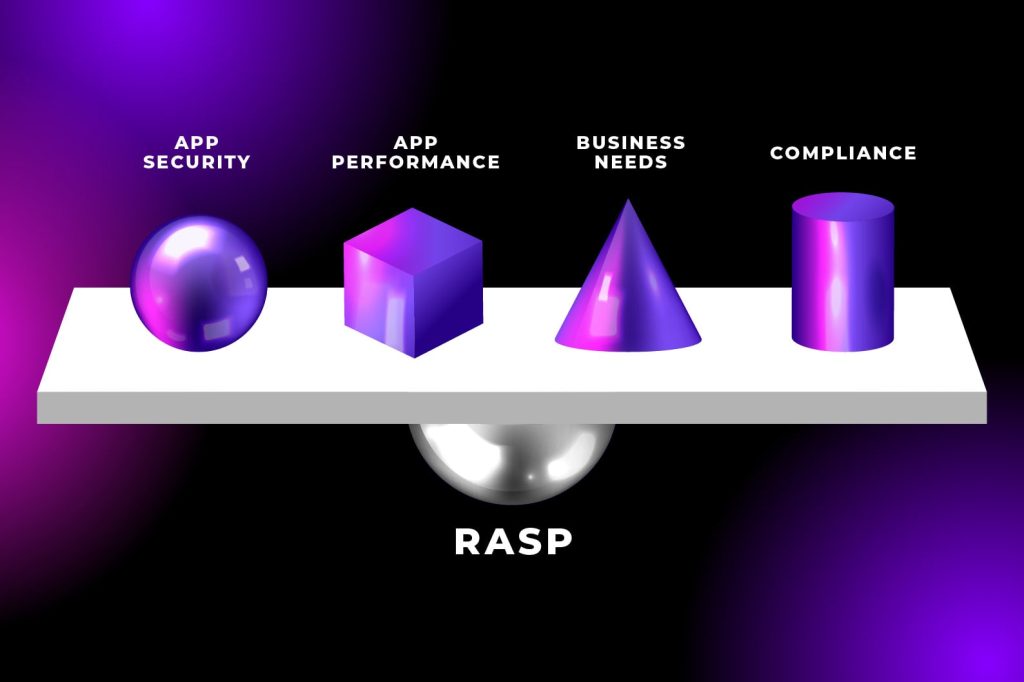In recent years, the digital landscape has undergone a remarkable transformation, marked by an unparalleled surge in mobile app usage. Mobile applications have become an inseparable part of our daily routines, catering to various needs and enhancing convenience.
However, as the popularity of mobile apps has soared, so has concern for their security. The ever-evolving tactics of cybercriminals pose significant risks, including data breaches, sensitive information theft, and potential financial and reputational harm to both users and app developers.
To combat these growing threats, the realm of security solutions has witnessed the rise of Runtime Application Self-Protection (RASP) as a formidable real-time defense mechanism for mobile application security.
What are the challenges faced by RASP solutions when protecting mobile apps?
RASP solutions have shown promise for bolstering mobile application security. However, they also encounter certain challenges and limitations that need to be addressed effectively.
1. Diverse mobile platforms and operating systems
The mobile app ecosystem is highly diverse, with apps running on various platforms, such as Android and iOS, each with its own operating system versions and device specifications. This diversity makes it challenging for RASP solutions to provide consistent protection across all platforms. RASP implementations may require customization for each environment, increasing complexity and maintenance efforts.
2. Limited control over the mobile environment
Unlike traditional web applications, mobile apps operate in a more controlled and restricted environment due to platform guidelines and app store policies. This limited control can hinder RASP’s ability to access critical runtime data and monitor app behavior effectively. RASP might face restrictions on certain mobile operating systems, limiting its ability to fully protect the app.
3. Secure data storage and transmission
Mobile apps handle sensitive user data, such as personal information, financial details, and login credentials. Ensuring secure data storage and transmission is essential to preventing data breaches. However, RASP might face challenges in inspecting encrypted data, making it difficult to detect attacks targeting data in transit or stored in encrypted form.
4. Mobile app reputation and third-party libraries
Mobile apps often rely on third-party libraries and components, and their trustworthiness might not always be guaranteed. Malicious or vulnerable third-party libraries can introduce security risks to the app, and RASP may have limited visibility into the behavior of these external components, making it challenging to identify and mitigate threats arising from them.
5. Offline mode vulnerabilities
Mobile apps frequently operate in offline or low-connectivity modes, which can increase security risks. In such scenarios, RASP may not have access to real-time threat intelligence or the ability to communicate with a centralized security server, potentially leaving the app exposed to attacks that would have otherwise been detected in an online environment.
6. Mobile device limitations
Mobile devices have inherent limitations in terms of processing power, memory, and battery life. RASP solutions must strike a balance between providing effective protection and minimizing the impact on the device’s performance and battery consumption. Resource-intensive RASP implementations might negatively affect the app’s usability and drain the device’s battery quickly.
7. Detection of sophisticated attacks
Advanced and sophisticated cyberattacks on mobile app vulnerabilities are becoming more prevalent. Attackers can use techniques like code obfuscation, polymorphism, and evasion tactics to bypass security measures, including RASP. Detecting and mitigating such attacks in real-time is a significant challenge for RASP solutions.
8. Constant updates and maintenance
To remain effective, RASP solutions must receive regular updates to address new threats and vulnerabilities. However, updating mobile apps can be a slower process compared to updating web applications, as users need to download and install the updates manually. Ensuring prompt and widespread deployment of RASP updates can be challenging for app developers and security teams.
The limitations of RASP security
There are some inherent drawbacks associated with RASP’s implementation in the context of mobile application security. App developers and security teams must be aware of the following limitations while implementing RASP to ensure they create a well-rounded and effective security strategy that protects their applications from a wide range of threats:
- False positives and false negatives
- Performance overhead
- Limited support for legacy systems
- Evolving threat landscape
- Compliance issues
Limitation #1: False positives and false negatives
One of the critical challenges faced by RASP solutions in mobile application security is the delicate balance between minimizing false positives and avoiding false negatives.
False positives
False positives occur when the RASP solution mistakenly identifies legitimate app behavior as malicious or suspicious. For example, certain app functionalities or user actions might trigger RASP alerts due to their similarity to attack patterns, leading to unnecessary security alerts. Frequent false positives can frustrate app users and lead to loss of trust in the security measures, prompting users to ignore genuine alerts.
Excessive false positives not only undermine user confidence but also create a considerable administrative burden. App developers and security teams may spend valuable time investigating and mitigating false alarms, diverting their attention from addressing genuine security threats. Moreover, false positives can lead to unnecessary blocking of app features or even temporary app suspensions, resulting in poor user experience and potential financial losses for businesses.
False negatives
On the other hand, false negatives occur when the RASP solution fails to detect genuine security threats. This can happen due to advanced attack techniques, evasion tactics, or limitations in the RASP’s rule set. Attackers constantly evolve their strategies, making it challenging for RASP to keep up with the ever-changing threat landscape.
False negatives pose a severe risk to mobile application security as they allow actual threats to go undetected and potentially exploit vulnerabilities. An undetected security breach can lead to data breaches, financial losses, reputational damage, and regulatory non-compliance. The inability to identify and thwart sophisticated attacks can severely undermine the credibility of RASP security and the overall security posture of the mobile app.
Consideration: Achieving a balanced approach
Balancing false positives and false negatives is a complex task that requires continuous fine-tuning of RASP rules and algorithms. Striking the right balance is crucial to ensuring that RASP effectively identifies and responds to genuine security threats while minimizing unnecessary disruptions to the app’s normal operation. This involves regular updates and collaboration with threat intelligence providers to stay informed about emerging attack patterns.
- Machine learning and behavioral analysis: To improve accuracy in threat detection, some advanced RASP solutions incorporate machine learning algorithms and behavioral analysis. Machine learning allows RASP to learn from historical data, improving its ability to distinguish between genuine app behavior and potential threats. Behavioral analysis monitors app activities over time, creating baselines for normal behavior and raising alerts when deviations occur.
- Customization and fine-tuning: App developers and security teams can customize RASP rules based on their app’s specific behavior and threat landscape. Fine-tuning RASP settings can help reduce false positives and increase the sensitivity to detect more sophisticated attacks tailored to the app’s context. However, striking the right balance requires a deep understanding of the app’s functionalities and potential security risks.
Limitation #2: Performance overhead
Performance overhead is a significant consideration when implementing RASP solutions for mobile application security. RASP can introduce certain performance implications that may impact the overall user experience and app responsiveness.
Real-time monitoring and analysis
RASP solutions work by continuously monitoring the runtime behavior of the mobile app and analyzing code execution for potential security threats. This real-time monitoring requires additional computational resources, including CPU cycles and memory usage. The constant analysis of app behavior can introduce overhead, especially in resource-constrained environments such as mobile devices with limited processing power and memory.
Impact on app responsiveness
For mobile apps, responsiveness is crucial to ensuring a smooth and seamless user experience. Any delay or lag in app responsiveness can frustrate users and lead to app abandonment. The performance overhead introduced by RASP can affect the app’s response time, making it slower to load, process user inputs, or execute certain tasks. Striking a balance between robust security and optimal app performance is, therefore, essential.
Battery consumption
Mobile devices are often powered by batteries, and users expect their apps to be energy-efficient. RASP’s continuous monitoring and analysis activities can increase the app’s energy consumption, draining the device’s battery more quickly. As mobile app users prioritize battery life, excessive energy usage due to RASP overhead may lead them to uninstall or avoid apps that noticeably impact battery performance.
Resource constraints
Many mobile devices have limited resources, such as RAM and CPU, compared to traditional desktop computers. RASP’s additional resource requirements may exacerbate resource constraints, leading to app crashes or reduced stability. In extreme cases, high resource consumption could even cause the app to fail or freeze, resulting in a poor user experience and negative reviews.
Impact of network latency
RASP solutions may interact with external security servers or threat intelligence sources to obtain real-time updates and threat data. Network latency and connectivity issues can add to the performance overhead, as delays in communication with remote servers can affect RASP’s responsiveness and real-time threat detection capabilities.
Continuous updates and maintenance
RASP solutions must be continuously updated to stay effective against new and evolving threats. Regular updates are necessary to keep the RASP rules and algorithms up-to-date with the latest attack techniques. However, frequent updates may lead to increased data usage and app download sizes, potentially affecting users on limited data plans.
Consideration: Balancing security and performance
Achieving a balance between robust security and optimal app performance is essential. App developers and security teams must carefully assess the impact of RASP on app performance and fine-tune the RASP settings accordingly. Striking the right balance ensures that security measures do not compromise user experience or app functionality.
- Optimization strategies: To minimize performance overhead, RASP developers employ various optimization strategies. These may include optimizing algorithms for efficiency, reducing the frequency of monitoring in less critical areas of the app, or providing configurable settings to allow users to adjust the level of RASP protection based on their device capabilities.
Limitation #3: Limited support for legacy systems
Legacy systems refer to older mobile applications that were developed using outdated technologies, programming languages, and frameworks. These apps might have been in use for an extended period and have not undergone significant updates or modernization efforts. Legacy apps can present unique challenges in terms of security, compatibility, and maintainability for RASP solutions.
Compatibility Issues
RASP solutions are typically designed to integrate seamlessly with modern applications that adhere to contemporary programming practices. However, legacy systems may lack the necessary hooks, APIs, or interfaces that RASP relies on for real-time monitoring and analysis. The lack of compatibility can hinder the smooth integration of RASP security into such applications.
Code complexity and technical debt
Legacy apps are often characterized by complex, monolithic codebases that have accumulated over time. Technical debt, arising from suboptimal coding practices and insufficient documentation, can make it challenging to understand and modify the app’s behavior effectively. This complexity can hinder RASP customization and fine-tuning to suit the app’s specific security needs.
Limited vendor support
As technology advances, software vendors may shift their focus to support more current technologies, leaving legacy systems without adequate vendor support. This lack of vendor assistance can pose challenges in obtaining RASP updates, security patches, and technical guidance for legacy applications.
Risks of retrofitting
Attempting to retrofit RASP security into a legacy application can be a daunting task. The process might require significant modifications to the app’s codebase, potentially introducing new bugs and security vulnerabilities. Additionally, modifying legacy code without comprehensive testing can lead to unintended consequences that compromise the app’s functionality and security.
Resource allocation
The allocation of resources for implementing RASP in legacy systems can be a contentious issue. Organizations may face a trade-off between investing time and effort in securing older applications versus migrating to newer, more secure platforms. Prioritizing RASP deployment in legacy systems requires careful consideration of the app’s criticality, user base, and potential security risks.
Consideration: Balancing security and business needs
Mobile apps, even legacy ones, may continue to serve critical business functions or have a substantial user base. Balancing the need to secure these apps against the practicality of upgrading or modernizing them can be a challenging decision for organizations. RASP implementation might be viewed as a stopgap measure to protect legacy apps until more comprehensive security strategies are established.
- Managing the end-of-life challenge: For certain legacy applications that have reached their end-of-life, organizations face an even more complex dilemma. Continued reliance on these apps might be necessary for business continuity, but the lack of ongoing support and updates raises security concerns. In such cases, organizations must carefully manage the risks and implement additional compensating security measures.
Limitation #4: Evolving threat landscape
The evolving threat landscape is a dynamic and persistent challenge that significantly impacts the effectiveness of RASP solutions in mobile application security.
Zero-day exploits
Zero-day exploits are vulnerabilities unknown to many app developers and vendors, making them particularly dangerous. Attackers actively search for and exploit these undisclosed mobile app vulnerabilities before they can be patched. RASP solutions must have the capability to detect and mitigate zero-day attacks, even without prior knowledge of the specific vulnerabilities.
Polymorphic and evasive attacks
Polymorphic attacks involve constantly changing attack patterns and malware characteristics to evade detection by security measures, including RASP. Evasive attacks employ tactics to hinder or deceive RASP’s monitoring and analysis, making them challenging to detect in real-time. RASP solutions must employ advanced detection techniques to identify and counter these evasive tactics effectively.
Targeted attacks on mobile apps
Mobile apps that handle sensitive data or have a large user base become attractive targets for attackers. Customized attacks aimed at specific mobile apps require RASP to be adaptable and capable of identifying app-specific threat patterns and behaviors.
Consideration: Rapid deployment of RASP updates
To remain effective against evolving threats, RASP solutions must have a mechanism for rapid deployment of updates. Timely updates that include new threat signatures, detection algorithms, and security patches are crucial to maintaining the highest level of security.
- Integration with threat intelligence: Access to real-time threat intelligence is essential for RASP to identify emerging threats promptly. RASP solutions should integrate with threat intelligence sources to receive up-to-date information about new attack techniques, malware, and vulnerabilities.
- Collaboration and information sharing: The cybersecurity community benefits from collaborative efforts and information sharing. RASP vendors, app developers, and security professionals must share insights and research findings to collectively improve RASP technology and stay ahead of evolving threats.
- Continuous monitoring and analysis: Mobile app behavior changes over time due to software updates, user behavior, and system configurations. RASP solutions must continuously monitor and analyze app behavior to adapt to these changes and maintain accurate threat detection capabilities.
- Machine learning and AI integration: Integrating machine learning and artificial intelligence (AI) capabilities into RASP can enhance its ability to detect and respond to complex threats. AI-driven RASP can learn from historical data, identify patterns, and predict potential attacks, bolstering the overall security posture of mobile apps.
- User awareness and education: RASP solutions are most effective when app users are aware of the potential security risks and take appropriate precautions. Educating users about safe app usage practices, such as avoiding suspicious links or granting unnecessary permissions, can reduce the likelihood of successful attacks.
Limitation #5: Compliance issues
RASP solutions play a crucial role in enhancing mobile application security, but their implementation can introduce certain challenges related to regulatory compliance.
Industry-specific regulations
Different industries, such as finance, healthcare, and government, are subject to specific regulations and data protection laws. These regulations mandate strict security measures to safeguard sensitive user data and ensure compliance. While RASP can bolster mobile application security, it may not cover all the specific requirements outlined in industry-specific regulations.
Data privacy compliance
Data privacy regulations, such as the General Data Protection Regulation (GDPR) in Europe or the California Consumer Privacy Act (CCPA) in the United States, impose strict rules on the collection, storage, and processing of user data. Organizations must ensure that RASP implementation aligns with these regulations to adequately protect user privacy.
Logging and auditing requirements
Certain compliance standards require detailed logging and auditing of security events. RASP solutions should provide comprehensive logs to track security incidents and facilitate audits. Incomplete or inadequate logging capabilities can hinder an organization’s ability to demonstrate compliance during an audit.
Secure data transmission
Compliance standards often demand secure data transmission, especially when sensitive information is exchanged between the app and remote servers. RASP solutions should be able to inspect and secure data transmission to comply with these requirements effectively.
Mobile app certification
In some cases, mobile apps must undergo certification or security assessments before they are approved for distribution or use. RASP implementations should be carefully reviewed to meet the certification criteria and security standards required by app marketplaces or regulatory bodies.
Real-time updates for compliance changes
Regulatory compliance requirements can change over time, necessitating updates to security measures and practices. RASP solutions should provide timely updates to adapt to these changes and ensure continuous compliance.
Cross-border data transfer
For organizations with a global presence, cross-border data transfer may be a compliance concern. RASP solutions must be capable of handling data transfers in compliance with the applicable laws and regulations of different countries.
Consideration: Balancing compliance and security
While RASP can enhance mobile application security, it is essential to strike a balance between compliance requirements and the app’s overall security needs. Organizations should assess the effectiveness of RASP in addressing specific compliance goals and consider complementary security measures to fully meet regulatory obligations.
- Transparent data handling: RASP solutions may process app data to monitor and analyze runtime behavior. App developers and organizations must be transparent about data handling practices and ensure compliance with relevant data protection laws and user consent requirements.
- RASP vendor compliance: When selecting a RASP solution, organizations should evaluate the vendor’s own compliance with industry standards and data protection regulations. Ensuring that the RASP vendor adheres to security and privacy best practices adds an additional layer of confidence in the solution.
By embracing a comprehensive security strategy and taking into account the limitations and challenges of RASP, organizations can strengthen their mobile application security and safeguard sensitive user data. Working in harmony with other security measures, RASP can become a vital component of a holistic security approach that fortifies mobile apps against a wide range of cyber threats.
Continuous vigilance and adaptability are essential to staying ahead of evolving threats and providing secure mobile experiences for users. Get in touch with one of our specialists, and we can start protecting your mobile app together.





